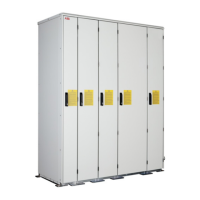62 Planning the electrical installation
Selecting the control cables
General rules
All control cables must be shielded.
The control cable shield should be earthed directly in the converter. The other end of the
shield should be left unconnected or earthed indirectly via a high frequency, high voltage
capacitor of a few nanofarads (eg, 3.3 nF / 3000 V). The screen can also be earthed
directly at both ends if they are in the same earth line with no significant voltage drop
between the end points.
Use a double shielded twisted pair cable (see figure a) for analog signals. This type of
cable is recommended for the pulse encoder signals also. Employ one individually
shielded pair for each signal. Do not use common return for different analog signals.
A double shielded cable is the best alternative for low voltage digital signals but single
shielded twisted multipair cable (figure b) is also usable.
Run analog and digital signals in separate, shielded cables.
Relay controlled signals, providing their voltage does not exceed 48 V, can be run in the
same cables as digital input signals. It is recommended that the relay controlled signals be
run as twisted pairs.
Relay cable
The cable type with braided metallic screen (eg, ÖLFLEX LAPPKABEL, Germany) has
been tested and approved by ABB.
Control panel cable
In remote use, the cable connecting the control panel (if any) to the converter must not
exceed 3 metres (10 ft). The cable type tested and approved by ABB is used in control
panel option kits. Control panel or cable is not included in the converter delivery. For
control panel, contact local ABB representative.
Routing the cables
Route the rotor cable away from other cable routes. It is recommended that the rotor
cable, grid cable and control cables be installed on separate trays. Avoid long parallel runs
of rotor cables with other cables in order to decrease electromagnetic interference caused
by the rapid changes in the rotor voltage.
Where control cables must cross grid cables and rotor cables, make sure they are
arranged at an angle as near to 90 degrees as possible. Do not run extra cables through
the converter.
The cable trays must have good electrical bonding to each other and to the grounding
electrodes. Aluminium tray systems can be used to improve local equalizing of potential.
a
Double shielded twisted multipair
cable
b
Single shielded twisted multipair
cable

